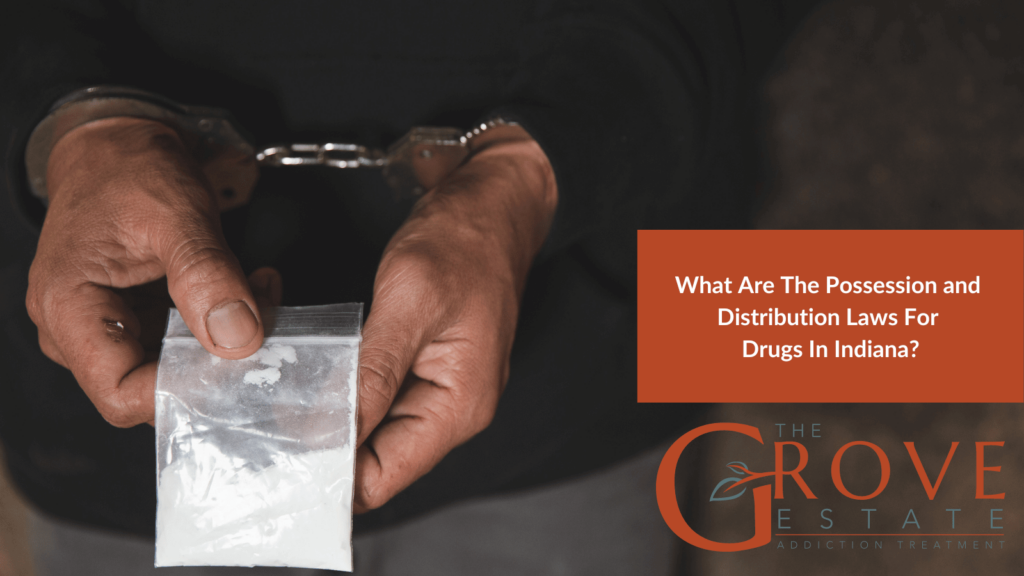Indiana’s drug laws distinguish between legal and illegal substances, with a focus on the severe penalties associated with possession and distribution. Recent data highlights a significant increase in drug-related convictions, particularly for marijuana, methamphetamine, cocaine, and narcotics. Notably, marijuana dealing and possession have surged by 493% and 177%, respectively. Methamphetamine-related offenses also show dramatic increases in both dealing (112%) and possession (502%) according to the Indiana Criminal Justice Institute.
The Hoosier state’s legal framework classifies drug offenses into different felony levels, reflecting the seriousness of each crime. Additionally, there’s a shift towards alternative sentencing over traditional jail time, aiming to address drug offenses more effectively.

What Are Indiana’s Drug Possession Laws and Penalties?
In Indiana, drug possession laws cover a broad spectrum, from simple misdemeanors to serious felonies with substantial penalties. For instance, possession of methamphetamine without a valid prescription is a criminal offense, and the severity escalates based on the amount of the substance involved. Less than 5 grams amounts to a Level 6 felony, while possession of 28 grams or more is a Level 3 felony. The severity of Indiana’s drug possession penalties is a clear indicator of the state’s stance on drug offenses, illustrating the escalating charges from misdemeanors to high-level felonies.
What are the classifications of Misdemeanors and Felonies?
Misdemeanors are categorized into three classes:
- Class A: The most serious, with penalties like fines up to $5,000, up to one year in jail, probation, or community service.
- Class B: Less severe than Class A, with fines up to $2,000, jail time up to six months, and possible probation or community service.
- Class C: The least serious, involving minor infractions with fines up to $1,000, brief jail terms, or community service.
Classes of felonies categorize offenses based on their seriousness and potential penalties. For example:
- Class A Felony: The most serious category, often involving violent crimes like murder or rape, with penalties that may include life imprisonment or the death penalty.
- Class B Felony: Less severe than Class A but still significant offenses such as robbery or aggravated assault, leading to several years to decades in prison.
- Class C Felony: Moderate severity crimes like burglary or certain drug trafficking offenses, resulting in several years in prison.
- Class D Felony: Typically non-violent offenses like fraud or theft, leading to several months to a few years in prison.
- Class E or F Felony: The least severe felony category, including crimes like embezzlement or certain drug possession offenses, with penalties such as probation, community service, or up to one year in jail.
Levels of felonies are another way of categorizing offenses, often used in specific jurisdictions. The levels may vary in terms of severity and potential penalties.
- Level 1 Felony: The most severe level, usually involving heinous crimes with the harshest penalties, such as life imprisonment or the death penalty.
- Level 2 Felony: Serious offenses but slightly less severe than Level 1, leading to lengthy prison sentences.
- Level 3 Felony: Moderate severity offenses, often resulting in several years in prison.
- Level 4 Felony: Less severe than Level 3, with penalties ranging from months to years in prison.
- Level 5 Felony: Typically non-violent crimes, leading to shorter prison terms or alternative sentences.
- Level 6 Felony: The least severe level, often involving less serious non-violent offenses, with penalties such as probation, community service, or up to one year in jail.
The Severity Scale: From Misdemeanors to Felonies
The severity scale for drug offenses in Indiana can be likened to a ladder, where each subsequent rung represents increased penalties. At the lower end of the scale, possession of fewer than 30 grams of marijuana without a prior drug offense is a Class B misdemeanor, holding lesser penalties compared to more severe drug offenses. However, a prior drug offense can elevate the possession of fewer than 30 grams of marijuana to a Class A misdemeanor, which carries potential sentencing of up to one year in prison.
As one moves up the scale, the stakes get higher. Possession of at least 30 grams of marijuana with a prior drug offense conviction is a more serious offense, potentially leading to a 6-month to 2.5-year jail term and a fine of up to $10,000.
When it comes to controlled substances like methamphetamine, cocaine, or narcotics, the penalties can be even more severe. Less than 5 grams can constitute a Level 6 felony without enhancing circumstances, and if the possession amount exceeds 10 grams, the offense reaches the Level 4 felony category.
Impact of Prior Convictions
In Indiana, having no previous drug offenses can lead to lighter charges. First-time offenders caught with less than 30 grams of marijuana or 5 grams of hashish, hash oil, or salvia might face a Class A misdemeanor. Possession above these amounts is a Level 6 felony with stricter penalties. A prior drug dealing conviction increases the severity for possessing 30 grams to 10 pounds of marijuana or 5 to 300 grams of hashish, hash oil, or salvia to a Level 5 felony. Previous convictions can significantly affect the penalties for drug offenses.
What are Indiana’s Controlled Substances Categories?
Drugs are not all categorized the same way in Indiana. Instead, they are divided into schedules based on their potential for abuse and medical use. In this classification system, the drug involved plays a crucial role in determining its schedule and potential consequences.
Between these two extremes, we find Schedule II, III, and IV drugs.
- Schedule II drugs include substances with a high risk of abuse and severe medical restrictions like cocaine, methamphetamines, and oxycodone.
- Schedule III drugs, characterized by a moderate risk of abuse, include anabolic steroids, ketamine, and codeine.
- Schedule IV drugs, which have a slight risk of dependency and are accepted for medical treatments, include benzodiazepines such as alprazolam and diazepam.
The categorization of these drugs can change, given that the Indiana State Board of Pharmacy holds the authority to recommend alterations to the drug schedules.
Prescription Drugs vs. Illegal Drugs
The line between legal and illegal drugs can be thin in Indiana. To legally possess pharmaceutical drugs, an individual must have a valid prescription from a practitioner, and the drugs must be dispensed by a pharmacy licensed to provide controlled substances. However, possession of a controlled substance without a valid prescription is a Class A misdemeanor if it involves Schedule I, II, III, or IV substances, excluding:
- Hashish
- Marijuana
- Synthetic cannabinoid
- Salvia
Moreover, it is illegal to possess more than four ounces of a Schedule V substance containing codeine within a 48-hour period without a valid prescription or without signing an exempt narcotic register maintained by a pharmacy. These laws emphasize the importance of a valid prescription in distinguishing between lawful and unlawful possession of drugs in Indiana.

What Are The Possession and Distribution Laws For Drugs Specific to Indiana?
In Indiana, drug possession and distribution are serious offenses. Charges for Possession with Intent to Distribute arise from controlling drugs with plans to distribute them, indicated by large quantities or distribution gear. Charges vary by drug type and amount. Selling 30 grams to less than 10 pounds can lead to a felony, with 6 months to 2.5 years in jail and fines up to $10,000. Selling 10 pounds or more also results in a felony, with 1 to 6 years imprisonment and up to $10,000 fines. Conspiring to commit a drug crime is punishable, showing the strictness of Indiana’s drug laws.
Marijuana Laws: Still Stringent in Indiana
Despite marijuana decriminalization trends in the US, Indiana has strict laws against its possession and distribution. Possessing marijuana, hash oil, hashish, or salvia can result in charges up to a Class B misdemeanor. For first-time offenders, having 30 grams or less of marijuana could mean up to 1 year in jail and $5,000 in fines. More than 30 grams increases the charge to a felony, with 6 months to 3 years in prison and up to $10,000 in fines. Penalties vary from Class B misdemeanor to Level 5 felony, reflecting Indiana’s strict stance on marijuana offenses.
Cocaine and Narcotics: Higher Stakes
In Indiana, cocaine and narcotics possession incurs severe penalties. Possessing any amount of cocaine is a Class D felony, escalating to a Class C felony for over 3 grams. First-time offenders with more than 3 grams face 2-8 years in prison and up to $10,000 in fines. Penalties increase near school properties: a Class B felony for under 3 grams and a Class A felony for 3 grams or more within 1000 feet of a school.
Charges can rise significantly with prior convictions or if drugs are delivered to minors, leading to longer prison terms and larger fines. Possession with intent to distribute, requiring evidence of at least 28 grams or intent for a drug transaction, also carries heavy charges, underscoring the high risks of narcotics possession in Indiana.
What Is Constructive vs. Actual Possession?
In Indiana drug laws, the notion of possession extends beyond merely having drugs in your possession. Indiana law recognizes both actual and constructive possession. Actual possession involves having the drugs physically on the person, while constructive possession refers to the intent and capability to maintain control and dominion over the drugs without having them on the person.
For a constructive possession charge in Indiana, it must be demonstrated that the individual knew about the drugs, had the capacity to control them, and intended to control them. Constructive possession could be deemed applicable in situations where drugs are located in possessions like a person’s vehicle, house, or any other property under their dominion.
In Indiana, the law presumes that if one has exclusive control over the premises where contraband is found, it reasonably infers possession. Additional evidence is necessary when exclusive possession is not evident.
Enhancing Circumstances
The concept of enhancing circumstances plays a significant role in Indiana drug laws. An ‘Enhancing Circumstance’ under Indiana Drug Laws is defined by Indiana Code 35-48-1-16.5. These circumstances include:
- having a prior conviction for dealing in a controlled substance
- possession of a firearm during the offense
- committing the offense in the presence of a minor
- on a school bus
- within 500 feet of school property
- on the property of a penal or juvenile facility.
Specific offenses such as manufacturing methamphetamine or financing the manufacture of drugs are designated as enhancing circumstances under Indiana drug laws. Such enhancing circumstances can considerably escalate charges, possibly leading to harsher sentences, including prolonged jail time and substantial fines.
What are the Legal Defenses Against Indiana Drug Charges?
Dealing with drug charges in Indiana can be daunting. However, there are legal defenses that can be employed against these charges. An Indiana Criminal Defense attorney is best suited to assess the potential application of these defenses. These attorneys perform thorough investigations to gather evidence and develop a solid defense strategy.
In court, an experienced criminal defense attorney prepares the case for trial, presents it effectively, and cross-examines witnesses. Seasoned criminal defense attorneys negotiate with the prosecution, aiming for the most favorable outcome, like minimized sentences or probation.
Constitutional Rights
Constitutional rights provide a robust foundation for legal defenses in drug cases. Infringement of Fourth Amendment rights during the search or seizure process can justify a request for the dismissal of drug charges. Evidence obtained in violation of the right to privacy or without proper legal grounds is subject to suppression to prevent its use in court. To better understand your options, consider scheduling a free consultation with a legal expert.
Under the Indiana Constitution’s Article I, Section 11, evidence collected through unreasonable searches and seizures may be suppressed. When circumstantial evidence fails to substantiate the charge beyond a reasonable doubt, challenging it becomes a crucial strategy to safeguard the defendant’s constitutional rights.

The Collateral Damage: Beyond Jail Time and Fines
Drug convictions in Indiana have significant collateral consequences, affecting employment, housing, and education opportunities. Convicted individuals may face license suspension, mandatory substance abuse treatment, and a permanent record, hindering social and professional integration. Indiana’s legal system includes over 650 post-conviction restrictions, presenting a challenging landscape for those with drug convictions. Nonetheless, the Second Chance Law in Indiana allows eligible individuals to petition for record restriction, potentially restoring rights and access to services, although results can vary.
How many grams is illegal in Indiana?
Possessing less than 30 grams of cannabis is illegal in Indiana and can result in a Class B misdemeanor offense.
What is the code for possession of drugs in Indiana?
In Indiana, the code for possession of drugs is 35-48-4-6. This section of the law outlines offenses and potential penalties for possessing specified drugs.
Is possession of Xanax a felony in Indiana?
No, possession of Xanax is not considered a felony in Indiana. It is classified as a Class A misdemeanor.
Are drugs legal in Indiana?
No, it is illegal to possess illegal drugs in Indiana. The state’s drug possession laws indicate that it is a criminal offense and can lead to misdemeanor or felony charges with severe penalties.
What is the difference between actual and constructive possession in Indiana drug laws?
In Indiana drug laws, the difference between actual and constructive possession lies in physically having the drugs on the person for actual possession, while constructive possession involves the intent and capability to maintain control over the drugs without physically having them.

Share This Post



